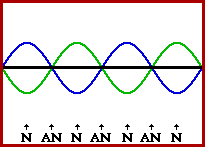
Standing Wave
Formation
A GIF Animation
The animation below depicts two waves moving through a medium in
opposite directions. The blue wave is moving to the right and the
green wave is moving to the left. As is the case in any situation in
which two waves meet while moving along the same medium, interference
will occur. The blue wave and the green wave will interfere to form a
new wave pattern known as the resultant. The resultant in the
animation below is shown in black. The resultant is merely the result
of the two individual waves - the blue wave and the green wave -
added together in accordance with the principle of superposition.

The result of the interference of the two waves above is a new
wave pattern known as a standing wave pattern. Standing waves are
produced whenever two waves of identical frequency interfere with one
another while traveling opposite directions along the same medium.
Standing wave patterns are characterized by certain fixed points
along the medium which undergo no displacement. These points of no
displacement are called nodes (nodes can be remembered as
points of no desplacement); the nodal
positions are labeled by an "N" in the animation above. The nodes are
always located at the same location along the medium, giving the
entire pattern an appearance of standing still (thus the name
"standing waves"). A careful inspection of the above animation will
reveal that the nodes are the result of the destructive interference
of the two interfering waves. At all times and at all nodal points,
the blue wave and the green wave interfere to completely destroy each
other, thus producing a node.
Midway between every consecutive nodal point are points which
undergo maximum displacement. These points are called anti-nodes; the
anti-nodal nodal positions are labeled by an "AN" in the animation
above. Anti-nodes are points along the medium which oscillate between
a large positive displacement and a large negative
displacement. A careful inspection of the above animation will reveal
that the anti-nodes are the result of the constructive interference
of the two interfering waves.
In conclusion, standing wave patterns are produced as the
result of the repeated interference of two waves of identical
frequency while moving in opposite directions along the same medium.
All standing wave patterns consist of nodes and anti-nodes. The nodes
are points of no displacement caused by the destructive interference
of the two waves. The anti-nodes result from the constructive
interference of the two waves and thus undergo maximum dispacement
from the rest position.
For more information on physical descriptions of waves,
visit
The
Physics Classroom. Specific information is available there on the
following topics:
Other animations can be seen at the
Multimedia
Physics Studios. Other useful resources regarding the physics of
motion and waves is available through the
Glenbrook
South Physics Home Page.
This page was created by
Tom
Henderson of
Glenbrook South
High School.
Comments and suggestions can be sent by e-mail to
Tom
Henderson.
This page last updated on 8/11/98.
